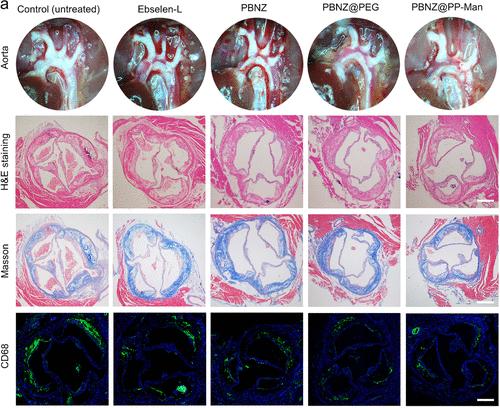对 "设计一种多功能纳米酶,用于解决促炎斑块微环境并减缓动脉粥样硬化 "的更正
IF 15.8
1区 材料科学
Q1 CHEMISTRY, MULTIDISCIPLINARY
引用次数: 0
摘要
原版文章中的图 7a 和图 8a 在编纂过程中出现了几处无心之失,作者对此深表遗憾。具体来说,原图中主动脉根切片的几张代表性图片被无意中误用。我们已用正确的代表图像替换了这些图像。这是一个诚实的错误。本文相应的正文和科学结论仍然正确,不受影响。图 7:(a)用 H&E、Masson 三色和巨噬细胞标记物 CD68 抗体染色整个主动脉弓(整体观察)和主动脉根部切片的代表性图像。刻度线代表 500 μm。图 8:(a)用 Ly6C(表明单核细胞浸润)、MMP-9(与斑块脆弱性有关)和 DHE(ROS 的荧光探针,在主动脉窦切片中用白色虚线圈出的红色荧光表示)抗体染色的主动脉根切片的代表性图像。刻度线代表 500 微米。更正已得到所有共同作者的认可。由于我们的疏忽给编辑和读者带来的不便,我们深表歉意。本文尚未被其他出版物引用。本文章由计算机程序翻译,如有差异,请以英文原文为准。

Correction to “Design of a Multifunctional Nanozyme for Resolving the Proinflammatory Plaque Microenvironment and Attenuating Atherosclerosis”
The authors regret that Figures 7a and 8a in the original version of the article contained several unintentional mistakes during the figure compilation process. In detail, a few representative images for aortic root sections in the original figures were inadvertently misused. We have replaced these with the correct representative images. This was an honest mistake. The corresponding main text and scientific conclusions in this paper remain correct and unaffected. Figure 7. (a) Representative images depict the entire aortic arch (visualized en bloc) and aortic root sections stained with H&E, Masson’s trichrome, and an antibody against the macrophage marker CD68. Scale bars represent 500 μm. Figure 8. (a) Representative images of aortic root sections stained with antibodies to Ly6C (indicating monocyte infiltration), MMP-9 (associated with plaque vulnerability), and DHE (a fluorescent probe for ROS, depicted by red fluorescence in the aortic sinus sections circled with white dotted lines). Scale bars represent 500 μm. The corrections have been approved by all coauthors. We sincerely apologize for the inconvenience caused to editors and readers due to our oversight. This article has not yet been cited by other publications.
求助全文
通过发布文献求助,成功后即可免费获取论文全文。
去求助
来源期刊

ACS Nano
工程技术-材料科学:综合
CiteScore
26.00
自引率
4.10%
发文量
1627
审稿时长
1.7 months
期刊介绍:
ACS Nano, published monthly, serves as an international forum for comprehensive articles on nanoscience and nanotechnology research at the intersections of chemistry, biology, materials science, physics, and engineering. The journal fosters communication among scientists in these communities, facilitating collaboration, new research opportunities, and advancements through discoveries. ACS Nano covers synthesis, assembly, characterization, theory, and simulation of nanostructures, nanobiotechnology, nanofabrication, methods and tools for nanoscience and nanotechnology, and self- and directed-assembly. Alongside original research articles, it offers thorough reviews, perspectives on cutting-edge research, and discussions envisioning the future of nanoscience and nanotechnology.
 求助内容:
求助内容: 应助结果提醒方式:
应助结果提醒方式:


